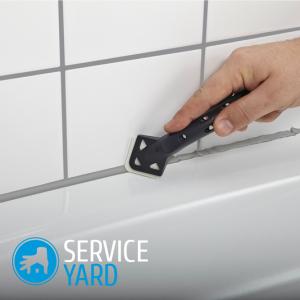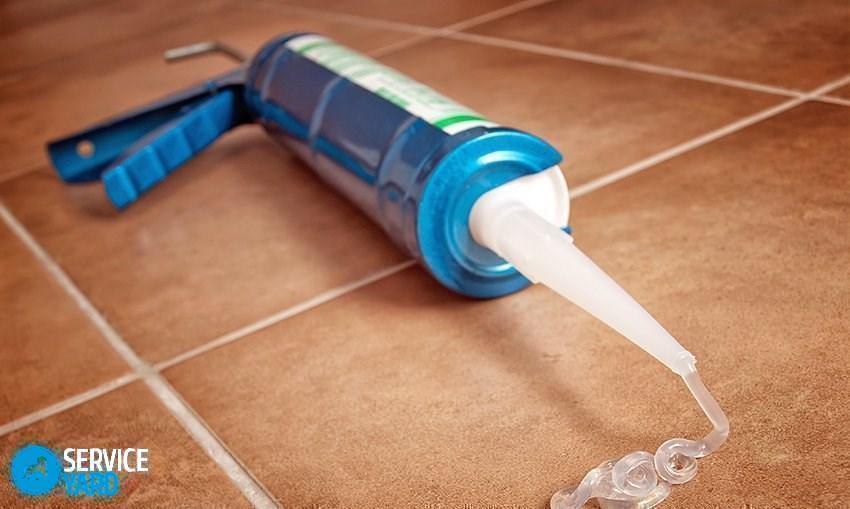How to remove silicone sealant from the bath?

Any owner of a shower or bath must face the need to remove silicone sealant from their surfaces. This composition is used for sealing joints and joints on plumbing equipment, as well as other household items. In this article we will tell you how to remove silicone sealant from the bathtub so that it pleases you with its attractiveness and cleanliness, because it is very important not to damage the surface of the sanitary ware when removing dirt.
to contents ↑Features of silicone sealant
Chemical inertness and high adhesion of silicone sealants after drying leads to the high complexity of their removal from various interior items. As a rule, it is possible to clear the surface of a composition that has polymerized, as a rule, only by applying a set of measures, which includes mechanical methods and methods using various chemical agents.
to contents ↑Important! First of all, you need to know that problems with removal arise only after the silicone sealant has completely dried, that is, when all solvent has completely evaporated from it. Hardened silicone is very difficult to remove, therefore, cleaning of its droplets and sagging must be done directly during construction work.
Mechanical cleaning method
Mechanical methods for removing silicone stains can only be applied to enameled bathtubs, glass surfaces, or ceramic tiles. This technique consists in scraping the hardened sealant with the following tools and materials:
- scrapers;
- spatulas;
- loose abrasive substances;
- chisels;
- scissors;
- graters;
- pumice;
- wallpaper or office knives;
- blades.
Before removing the silicone sealant from the bath, the protruding layer of the building compound is cut off with a knife or other tool. After this procedure, the remaining traces of contamination are removed with pumice, sandpaper or other abrasive compounds.
Removing remaining contaminants
After complete removal of the silicone, its location will be clearly visible as a greasy, dirty stain. You can clean it with loose products for the care of kitchen surfaces. To achieve the highest quality result, they must be used according to the following algorithm:
- The cleaning composition is applied to a kitchen sponge or washcloth.
- Neat, thorough, circular movements clean the surface.
- The stained area is wiped with any liquid detergent at hand and washed thoroughly with hot water.
to contents ↑Important! If the processing site is well prepared before sealing, and it represents a smooth, shiny surface, then it will be practically impossible to remove silicone residues without using special chemical compounds. In this case, you will come to the rescue ordinary building hair dryer. If the silicone sealant is heated to 400 ° C, then it will simply peel off from the plumbing.
Folk cleaning methods
If in solving the problem of wiping silicone sealant from the bath, for some reason you do not want to use specially developed chemical compounds, then you can use one of the proven alternative methods:
Salt
To achieve the desired cleansing effect using ordinary table salt, it must be used in the following way:
- Take a small piece of gauze.
- Fold the textile material in 4-5 layers.
- Moisten the salt slightly until gruel forms.
- Dip a gauze swab in the resulting composition.
- Wipe off greasy residue from sealant.
Important! It is necessary to clean the place of contamination, without applying effort, with a slight pressure. Also make sure that the salt is constantly wet.
The success of such a cleaning procedure depends mainly on the material from which the bathtub is made, the quality of the silicone, as well as the age of contamination. Nevertheless, it is necessary to take into account the reviews of people who have used this method and confirm the effectiveness of the use of salt in the struggle for the cleanliness of plumbing.
Chemicals at hand
You can remove a layer of old, dried silicone using any solvent, including those remaining in the house after painting or repair work. For such purposes, the following chemical compositions are suitable:
- White Spirit;
- gasoline "Kalosha";
- acetone;
- organic or inorganic solvents.
Important! You should be aware that long-standing silicone stains are quite persistent, so you won’t be able to “take them off the hook”.
Using any means, it is necessary to take into account such features of this process:
- A thick layer of hardened sealant is removed first using mechanical devices. To do this, use knives or other sharp cutting tools, trying as much as possible to clean the subject of contamination.
- After mechanical removal, a solvent, gasoline or acetone is applied to the remaining stain with a rag.
- After some time, the silicone softens and turns into a jelly-like mass. Now it will be much easier to remove it from the surface. Most likely, you will need several attempts to pry and raise the edge of the sealant to completely remove it.
- Sprinkle the remaining grease stain with soda, moisten with water and finish with a clean circular motion.
- Using hot water with soap or any washing powder, we carry out the final washing.
to contents ↑Important! It best dissolves organosilicon compounds, to which silicone belongs, the well-known white spirit solvent. This chemical can be found in almost every home arsenal. Therefore, we advise you to use it first.
Special washes for silicone
The industry has developed a huge number of special chemicals to remove silicone contaminants. The following formulations have proven themselves excellently:
- Dow Corning OS-2;
- Quilosa Limpiador;
- Sili-kill;
- Silikon-Entferner;
- Penta-840.
Important! The cleaning procedure should always be carried out with gloves. If an aerosol cleaner is used, it is necessary to take care of additional personal protective equipment - a respirator and glasses.
 To achieve the highest quality cleaning effect, washes or cleaners are used according to the following algorithm:
To achieve the highest quality cleaning effect, washes or cleaners are used according to the following algorithm:
- Using a soft cloth, spray or brush, apply the selected composition to the area of contamination.
- We stand it for some time.
- We remove the remains of silicone sealant.
- After removing silicone glue from the surface of the bath, it must be washed with warm water using soap or any other detergent.
to contents ↑Important! Before applying the chemical product to the contaminated area, you should try to clean the stain in some inconspicuous place. Using this simple method, you can protect the bathtub from damage if the chemical composition of the cleaner is aggressive to the material from which it is made.
Features of removing silicone sealant from various surfaces
Before choosing a method, than cleaning the sealant from the bath, you need to pay attention to the material of its manufacture:
Enameled surface
It must be remembered that even enameled products require extremely careful handling. Therefore, when cleaning, try not to damage the top layer of enamel.
Important! Enamelled steel bathtubs are suitable for any cleaning products - removing contaminants using chemicals and mechanical cleaning methods.
Tiled plumbing
Bathtubs, which are tiled, are also quite resistant to cleaning substances. Just as in the case of cleaning enameled coatings, the tile material should be treated carefully and carefully, being careful not to damage its glossy surface.
Acrylic bathtubs
If you own an acrylic bath, then you need to choose special compounds for this type of plumbing. The substances that make up their composition will retain the surface layer of your product and will only respond to a stain of silicone.
Important! Dow Corning OS-2, a fairly common tool in the distribution network, also received a lot of good reviews. After applying it to the stain, the sealant softens very quickly and is easily removed.
In no case should organic solvents be used as they damage shiny acrylic surfaces. You should also refrain from the temptation to remove silicone with a knife or other metal objects.
to contents ↑Stock footage
It must be remembered that the problem is easier to prevent than to fix. Therefore, you should not allow the surface of your bath to become contaminated with silicone. If such a nuisance did occur, try to remove the stain immediately, cleaning the contaminated area using one of the above methods.
- How to choose a vacuum cleaner taking into account the characteristics of the house and coatings?
- What to look for when choosing a water delivery
- How to quickly create comfort at home - tips for housewives
- How to choose the perfect TV - useful tips
- What to look for when choosing blinds
- What should be running shoes?
- What useful things can you buy in a hardware store
- Iphone 11 pro max review
- Than iPhone is better than Android smartphones



